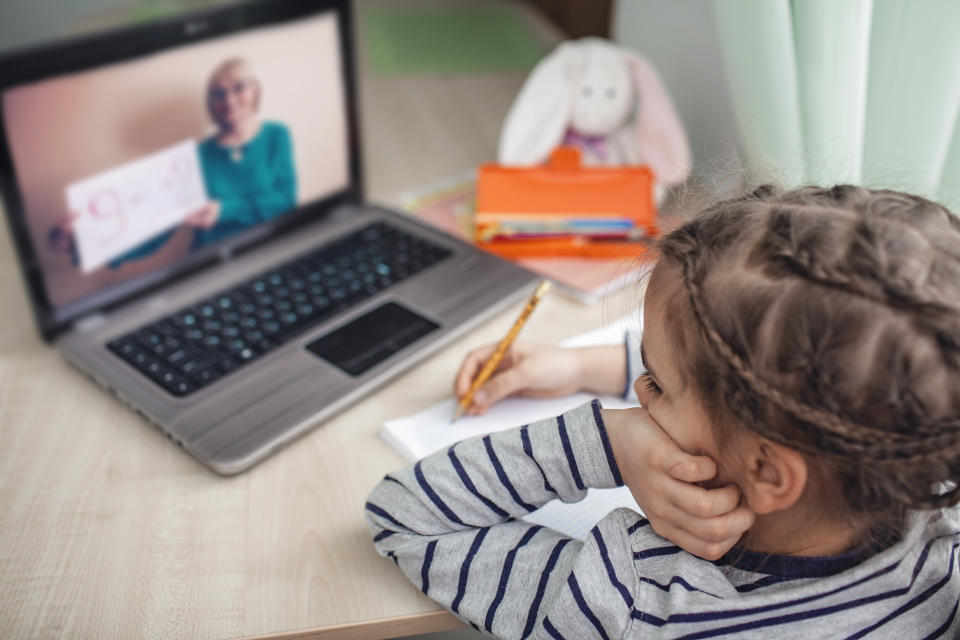Wi-Fi buses and beyond: How schools are creating internet hotspots for students in the era of remote learning

With this unprecedented school year just beginning, many districts across the country have had to figure out ways to ensure their students remain connected.
According to a June study done by Common Sense Media and Boston Consulting Group, about 15 to 16 million K-12 public school students have no access to internet, or devices equipped for distance learning at home. A viral picture of two students doing school work outside of a Taco Bell in Salinas, Calif. last month further illustrated the digital equity gap.
2 of our children trying to get WiFi for their classes outside a Taco Bell in East Salinas! We must do better & solve this digital divide once &for all for all California students
CALIFORNIA NEEDS A UNIVERSAL BROADBAND INFRASTRUCTURE BOND FOR OUR STUDENTShttps://t.co/qEjWTTs6G8 pic.twitter.com/cAbXNJ6F7x— Luis Alejo (@SupervisorAlejo) August 26, 2020
In May, as the coronavirus pandemic shut down countless schools across the country, several school districts in Dayton, Ohio, Austin, Texas, Carbondale, Ill. and others were using school buses to provide Wi-Fi to students as they finished the year at home. With the new academic year already here, many schools have decided to either expand or diminish the program.
In Ohio, the Dayton Public School District has decided to have K-12 students attend virtually for the first nine weeks of school. According to the district’s website, students will watch pre-recorded lessons in the morning with groups of students able to interact with their teachers live in the afternoon. In addition to providing school supplies and Chromebooks, a spokesperson for the school district tells Yahoo Life that they are also helping students with access to Wi-Fi.
“The district has provided Wi-Fi hotspots to all students who requested one in order to learn from home for the first nine weeks,” spokesperson Alex Kincaid says. “Students can still call to request a hotspot at any time throughout virtual learning.”
Mosinee School District in Mosinee, Wis. is undergoing a similar initiative while also continuing to utilize school buses.
“We are still operating a [school bus] program, but have now morphed it from buses being parked around town to individual hotspots sent out with families that need coverage,” Brady Mesenberg, director of technology, tells Yahoo Life.
Some school districts have actually expanded the reach of the Wi-Fi school bus program. The Austin Independent School District (AISD) will be using the hybrid reopening approach after the first month of school. They will allow a 100 percent virtual-learning option to students, but with officials only allowing up to 25 percent student capacity on each of their campuses, there will be a lot of children and teens who will need to rely on internet connectivity for their education.
In a statement to Yahoo Life, Cristina Nguyen, a spokesperson for AISD, says that they have doubled the amount of Wi-Fi buses in their “high-density” communities.
“We opened our district with four weeks of remote, off-campus learning so during that time we wanted to think creatively about how we could use our transportation fleet to support that online learning while the buses aren't transporting students to/from school,” she adds. “We've also distributed more than 15,000 Wi-Fi hotspots for our students and we have an additional 10,000 more hotspots on the way.”
Several school districts have gotten rid of the Wi-Fi bus program all together, including Hoover City Schools in Hoover, Ala., which will use a hybrid model with students attending in-person classes on different days.
“We did experiment with Wi-Fi buses back in the spring, and those buses remain equipped as such,” Jason Gaston, a district spokesperson explains. “However, we ran data each night and discovered surprisingly low utilization rates. Thus, we don't have them for this school year. We are a highly connected community with regard to internet connectivity and as we learn of families who might need extra support in terms of devices/connectivity, we provide it.”
Despite the district no longer continuing the bus program, the state offers the Alabama Broadband Connectivity (ABC) Program for Students, which, according to the program’s website, received $100 million in Coronavirus Aid, Relief, and Economic Security (CARES) Act funding from Governor Kay Ivey. Eligible students enrolled in the National School Lunch Program (NSLP) received a prepaid voucher at the end of August for free internet from the provider of their choice.
In Topeka, Kan., students of the Topeka Public School District, which had also previously provided Wi-Fi buses, students who participate in NSLP, Supplemental Nutrition Assistance Program (SNAP), Temporary Assistance for Needy Families (TANF) or public housing programs are eligible for a free trial with Cox Communications. The company is providing those students with a 30-day free trial of their Connect2Complete program; after the trial their families will pay a reduced monthly price. Topeka has also begun working with the Topeka Rescue Mission to provide hotspots to each family living at the mission.
For the latest coronavirus news and updates, follow along at https://news.yahoo.com/coronavirus. According to experts, people over 60 and those who are immunocompromised continue to be the most at risk. If you have questions, please reference the CDC’s and WHO’s resource guides.
How to maintain your physical and mental health during the pandemic
Taking care of a loved one with COVID-19? Here’s how to stay healthy
Q&A with Dr. Kavita Patel: How to keep your family safe and maintain your mental health
Read more from Yahoo Life:
Want lifestyle and wellness news delivered to your inbox? Sign up here for Yahoo Life’s newsletter.


